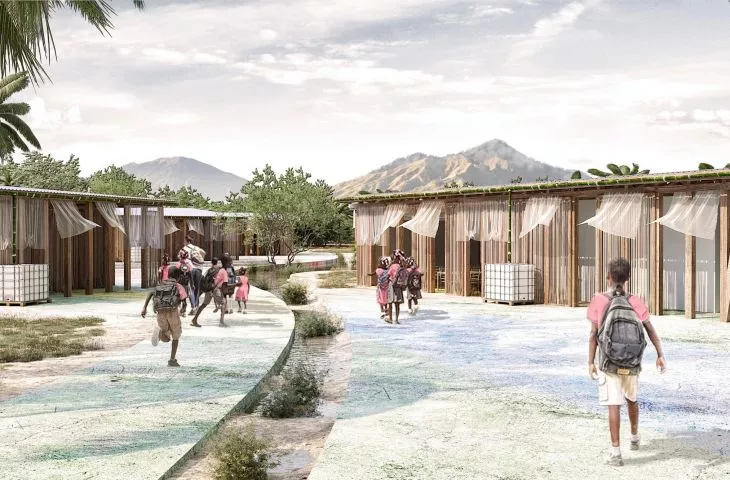Disaster-stricken communities lose homes, schools and jobs in an instant, and it can take years to rebuild them. In the face of disaster, properly shaped architecture can become a helpful solution, providing a chance to recover from the crisis. Concerned about the situation of education in Haiti, {tag:studenci} designed a modular and simple-to-build school complex.
The aim of Agnieszka Chudy's master's thesis, done under the supervision of Dr. Marcin Gawlicki at the Sopot Academy of Applied Sciences, was to present how to model a rural school complex using Haiti as an example.
A rural school complex in Haiti consists of easy-to-build facilities
© Agnieszka Chudy
zaspół szkoły na Haiti
The author's intention was to create a solution that can be implemented in areas with difficult conditions. In particular, in the equatorial climate zone and areas prone to natural disasters. Her goal is also to develop practical possibilities for erecting natural buildings, adapted to the region, with materials available there. The architect tried to answer the question: how to find and combine the architectural elements of the space, the ways of erecting buildings, the availability of materials and the mentality of the community in the face of a disaster?
all objects were made of local materials
© Agnieszka Chudy
To achieve her goals, Agnieszka analyzed the local conditions of the Haiti area to develop the simplest and low-cost form of building. She chose the site of the current temporary school and areas in the equatorial climate zone as her research area. The school complex she designed includes seven grade levels and is designed for about fifty children from the local community. The author planned to create two, model village housing complexes.
The determinant of the scheme for the distribution of buildings was the arrangement of trees
© Agnieszka Chudy
phased construction of the school
The architect created a design consisting of the minimum required areas, rooms and spaces. Staging the premise into four implementation phases allows for efficient construction. Each phase is independent of the next and does not affect the already realized. The first is the construction of elements necessary for the operation of the school, namely two classrooms, sanitary facilities (toilets and a nursing room). The second phase will increase the school's capacity while improving its quality. In this phase, the author proposes the construction of two more classrooms, as well as a multipurpose room connected to a food preparation and consumption area.
The first phase of construction includes the creation of two classrooms
© Agnieszka Chudy
Thethird phase includes the development of the surroundings of the school complex buildings in accordance with the designated program and the introduction of self-sustaining solutions. On the other hand, the construction process of the second school complex depends on the needs of the community. The author proposes to create a space for the local community and children. There will also be a place for the production of local products. The buildings are made of local materials (Paulownia-oxytree wood, bamboo, coconut, cane) combined with clay.
The buildings are constructed in stages from modules
© Agnieszka Chudy
Modules and flooring made of local materials
The construction of the school complex is based on a simple, repetitive module. The determinant of the building layout scheme was the arrangement of trees on the plot and an analysis of the sun's wandering. The starting point became the geodetic determinant for the subsequent development of the space. Surplus material excavated from the site was used to create and form steps, walls, other elevations of the floor, which connects all the buildings of the complex. The color of the floor was obtained by mixing clay with admixtures of other rocks, water, sand, concrete and natural pigments (marl, stoneware, limestone coral, conglomerates of volcanic rocks).
Throughout the facility there is a floor made of natural materials
© Agnieszka Chudy
The color reference is a reference to traditional Haitian painting, saturated with colors. The floor also promotes the microclimate of the site. In the carved depression, water will accumulate during the rainy season, resulting in better drainage from the topsoil to other areas outside the school buildings. On the other hand, during the dry season, the created water trough can be filled with harvested rainwater collected from the designed underground and above-ground tanks, explains Agnieszka Chudy.
The school facilities are created from simple and natural materials and those that have been grown through the implementation of crops. They are made using the cordwood technique, a combination of clay and wood. Structural woods used in the project include mahogany, bamboo, sugar cane, proper coconut, coconut palm and prickly pear.
regenerative design
The architect also planned to use waste materials. Non-utilitarian parts of the plants, discarded after harvesting the crops, are stored in a composting area, from which biofuel can be produced. In addition, two clay ovens have been placed in the vicinity of the crops for processing and drying the grown plants. In these areas, the author also designed underground niches for storing the crops. An important element of the development, there is also a tunnel connecting the school complexes, protecting them from hurricanes.
The school grounds also include publicly accessible buildings and fields of crops
© Agnieszka Chudy
The project aims to reduce the impact on the environment, soil and water conditions and air pollution. The author's main intention is to minimize ecological losses and preserve and increase biologically active area. The modularity of the buildings is characterized by high mobility and self-sufficiency. It also allows quick arrangement and creation of custom structures typical of crisis solutions, including small residential houses.
Architects won't win against nature, but they can try to learn from nature's vitality so as to create buildings and cities that can be reborn after a disaster in harmony with local conditions, material availability, social consciousness and culture. Regenerative design reaches beyond sustainable development and talks about objects as active elements of the natural environment with a social context, Agnieszka Chudy concludes.























































